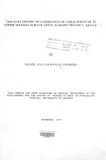| dc.description.abstract | The study covers Kajiado District with a special focus on
Upper Matasia Sub-location of Ngong Division. It investigates the
impact of socio-cultural, socio-economic, health and environmental
factors on child survival. Two data sets are utilized - secondary
data from the 1979 population census and primary data from a survey
done at Upper Matasia sub-location.
Chapter one presents background information on Kajiado
district and the problem under study. Chapter two presents
literature related to the study topic and the theoretical
framework, while chapter three presents the methodologies that have
been utilized. The Coale and Trussell indirect technique of
estimating mortality has been utilized in the analysis of the
census data. The q(2) value i.e. the probability of a child dying
by exact age two, Infant Mortality Rate and eo i.e. life expectancy
at birth have been used to depict mortal ity conditions in the
district. The results of the analysis are presented in chapter
four. In the anatysis of survey data, a method developed by
Preston and Trussell in 1982 of calculating mortality index, has
been utilized. This ratio of observed to expected deaths, is the
dependent variable both in the cross-tabulation and multiple
regression analyses. The results of the two analyses are presented
in chapter five.
The main finding of the census data analysis is that, rural
areas have lower mortality levels and hence higher life
expectancies than urban areas. Another important finding is that,
whereas the other divisions Loitokitok and Central show a
declining trend in mortality since 1976, Ngong division exhibits a
steep increase in mortality from early 1977.
The results of cross-tabulation and mUltiple regression
analysis show that health, environmental and socio-economic factors
have a close relationship with mortality.
Health factors which include immunization, attendance of antenatal
clinic, place of delivery, assistant at birth for home
deliveries and treatment of umbilical cord wound signif icantly
affect child survival.
Environmental factors particularly type of toilet facility and
source of water during wet season and the socio-economic factor,
education, also significantly affect child survival.
socio-cultural factors which include, age at supplementation,
breast-feeding, length of breast-feeding, marital status, type of
marriage, and age at first birth on the other hand, did not show
any significant effect on child survival.
On the basis of these findings, this study recommends that
efforts should be made to increase the number of health facilities,
coupled with training of medical personnel especially traditional
birth attendants and family planning service providers and public
education to sensitise people to the need to utilize health
services and also importance of personal hygiene.
Immunization programmes should also be expanded and more antenatal
clinics established with ease of accessibility to the
population as the priority. | en |

